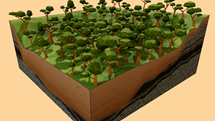
The School of Minerals and Energy Resources Engineering has produced The Resource Rehabilitation Showcase, in collaboration with Australian Earth Science Education and Vantage Interactive, and with the support of many generous contributors such as Genex Power, The Upper Hunter Mining Dialogue, The Climate Council, Mangoola Coal, NSW Planning, Weipa Bauxite Mine, Chevron Australia, Woodside Petroleum, and ERA Mine.
As minerals and energy resources are essential for the survival of humanity, the extraction of geo-resources must be done safely and sustainably. After resources have been extracted, the land needs to be rehabilitated to its original setting. In Australian states such as New South Wales, rehabilitation is a requirement for all mining operations . The Australian approach to rehabilitation of mining sites is regarded as the leading practice in the world and includes :
• long-term stability and sustainability of the landforms, soils and hydrology of the site
• restoration of the ecosystem to provide habitats
• zero pollution to the surrounding environment
• maximum benefits to the society
The Resource Rehabilitation Showcase is an interactive virtual tour where you can visit different operations across gold, oil & gas, coal, uranium, silica, and aluminium. Throughout the tour you will learn about:
• how these sites plan for closure
• managing environmental factors
• varieties of rehabilitation options after resource extraction has been completed.
The Showcase allows viewers to explore sites all across Australia from the comfort of their own device and includes 3D animated models of the rehabilitation to aid learning.
Along the tour there are many interviews to listen to people who are workers, or key stakeholders of the operations. A range of issues are discussed, including consultation with traditional owners, water management, vegetation assessment, biodiversity mapping, water-table protection and worker safety.
The showcase allows a behind the scenes look at resource operations from before, to during, to rehabilitation and what it looks like many years into the future.
“A key learning point is that there are options for rehabilitation thanks to resource extraction, such as being able to create a pumped hydro-electric power generation site, or an artificial reef”.
In some cases, returning the land to the same exact state as before mining is not always the best option. Rehabilitation to thick vegetation is also showcased, as well as rehabilitation to coastal vegetation and to farmland.
Rehabilitation To Thick Vegetation
Some resources are located under areas of thick vegetation. As part of a mine's approval to operate, they may be required to rehabilitate the mined land back to a similar (or better) state when they are finished. The presence of bird and animal life within these regions are great signs that the ecosystem is re-establishing well.
Rehabilitation To Coastal Vegetation
Everyone loves the beach! Our coastal regions are valuable, sensitive and need to be looked after. Many sand mines have operated along Australia's coastline over the years. They have returned the land to such a state, that it is almost unbelievable that a mining operation ever occurred. That’s what is the invisible zero harm mining!
Working In Sensitive Environments
Not all mining environments are created equal. Some contain many challenges that a mining company will need to manage and be held accountable for. Regulators and auditors help to ensure that a mine's impact is being monitored and the surrounding environment is being protected correctly.
Working With Traditional Owners
It is important to understand the significance of the land that mines are operating on and learn from the traditional owners. Their expert advice is vital through the planning process, vegetation assessment, seed collection, and all the way to rehabilitation.
Rehabilitation To Pumped Hydro Power
Imagine using mined land to produce renewable energy. Transforming giant mine pits into a battery system that can help power thousands of homes. Now that's a light bulb moment!
Rehabilitation To Artificial Reef
Some areas of the sea floor don't contain much of a structure for fish to use as a habitat. The structure of an oil rig starts to attract fish very quickly and they love hiding around the columns. Petroleum companies are able to generate great underwater playgrounds for fish from old oil rig structures.
Rehabilitation To Farmland
In some cases, valuable resources can be located underneath farming land. Modern gas extraction minimises the area of disturbed land. The land between well sites is often able to be farmed whilst the land is producing gas. This land can also easily be turned back into farming land after the resource extraction has been completed.
